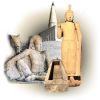අනුරාධපුර යුගය
3rd BC - 10th AD
Several centuries before the Jesus Christ, while the Greek empire was at its zenith, many other regions were emerging from the stone age; Anurdhapura was already and advanced civilization. The city was well laid out and well linked. Irrigated by sophisticated systems of man-made lake s and canals, this city was a world trade center. This is evidenced by the Greek merchant guide book titled "purples of the Erythraen Sea", Ptolemy's first ever map, and further by monk travelers Fa Hien and Buddagosha of, the 5 th century A. D.
Anuradhapura was known from Tibet to Yellow Sea.
But unlike Greek and Roman ruins, Anuradhapura has only the remains of a monastic architecture. This city's name means the City of Anuradha.
Anuradha was the first general of the king Vijaya: the legendary ancestor of the Sinhalese race. The city measured 52 square kilometers' and was maintained by at least 500 scavengers.
The city was divided into several quarters.
Foreign traders lived in one quarter. Their houses were of 2 or 3 stories. Artisans occupied some avenues.
Listing Details
Address



